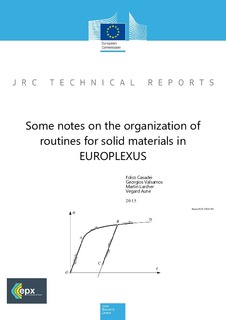Some notes on the organization of routines for solid materials in EUROPLEXUS
Research report
Published version
Permanent lenke
http://hdl.handle.net/11250/2456016Utgivelsesdato
2015Metadata
Vis full innførselSamlinger
Sammendrag
This document describes the organization of some routines for the modelling of solid materials in the EUROPLEXUS computer code (EPX) at the Joint Research Center (JRC) of the European Commission (EC) at Ispra. EPX is a computer code jointly developed by the French Commissariat à l’Energie Atomique (CEA DMT Saclay) and by EC-JRC IPSC. The code application domain is the numerical simulation of fast transient phenomena such as explosions, crashes and impacts in complex three-dimensional fluid-structure systems. The EPX code contains libraries of element types (about 150 types) and of material types (about 120 types). See [1] for details. Elements cover 1D, 2D and 3D geometrical situations. Some of them (namely some general-purpose continuum elements) can be used to discretize both the structural and the fluid domain. Others are specific to either fluid or structural applications. To the latter category belong the so-called “structural” elements, namely bars, beams and shells. Materials are either fluid or solid (structural). Only some (meaningful) combinations of elements and materials are allowed in the code. For example, a structural element can be assigned a solid material, but not a fluid material. This document illustrates some practical and programming aspects on the organization of solid material models in EPX in order to provide a reference for adding new material models of this type in the code.
